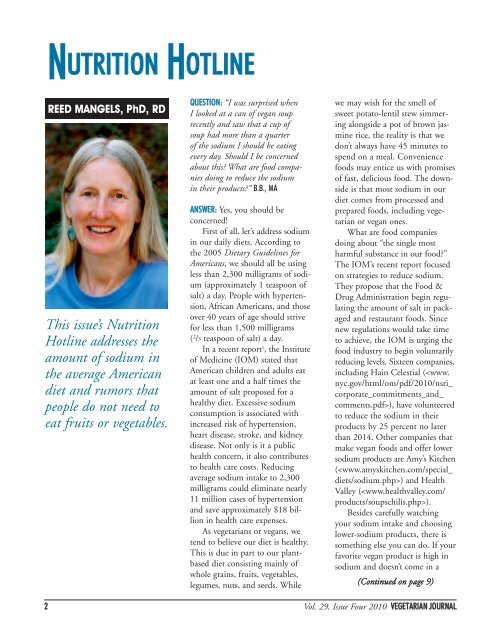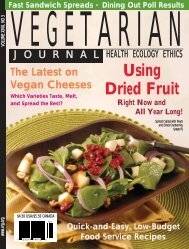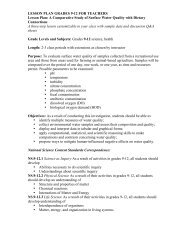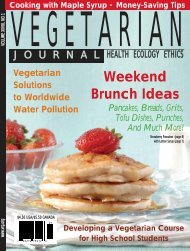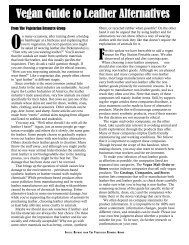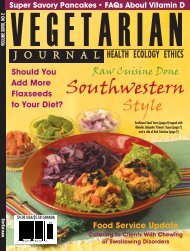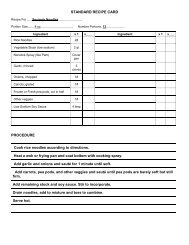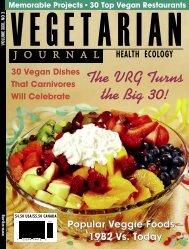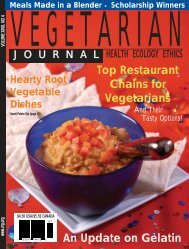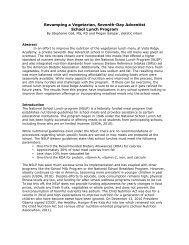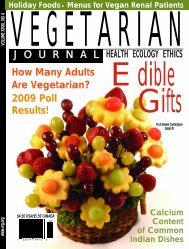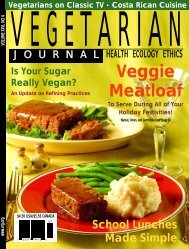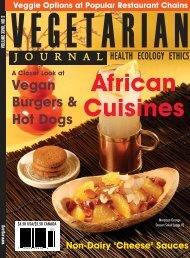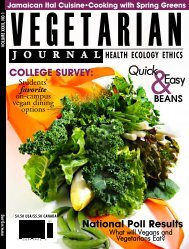NUTRITION HOTLINEREED MANGELS, PhD, RDThis issue’s NutritionHotline addresses theamount of sodium inthe average Americandiet and rumors thatpeople do not need toeat fruits or vegetables.QUESTION: “I was surprised whenI looked at a can of vegan souprecently and saw that a cup ofsoup had more than a quarterof the sodium I should be eatingevery day. Should I be concernedabout this? What are food companiesdoing to reduce the sodiumin their products?” B.B., MAANSWER: Yes, you should beconcerned!First of all, let’s address sodiumin our daily diets. According tothe 2005 Dietary Guidelines forAmericans, we should all be usingless than 2,300 milligrams of sodium(approximately 1 teaspoon ofsalt) a day. People with hypertension,African Americans, and thoseover 40 years of age should strivefor less than 1,500 milligrams( 2 /3 teaspoon of salt) a day.In a recent report 1 , the Instituteof Medicine (IOM) stated thatAmerican children and adults eatat least one and a half times theamount of salt proposed for ahealthy diet. Excessive sodiumconsumption is associated withincreased risk of hypertension,heart disease, stroke, and kidneydisease. Not only is it a publichealth concern, it also contributesto health care costs. Reducingaverage sodium intake to 2,300milligrams could eliminate nearly11 million cases of hypertensionand save approximately $18 billionin health care expenses.As vegetarians or vegans, wetend to believe our diet is healthy.This is due in part to our plantbaseddiet consisting mainly ofwhole grains, fruits, vegetables,legumes, nuts, and seeds. Whilewe may wish for the smell ofsweet potato-lentil stew simmeringalongside a pot of brown jasminerice, the reality is that wedon’t always have 45 minutes tospend on a meal. Conveniencefoods may entice us with promisesof fast, delicious food. <strong>The</strong> downsideis that most sodium in ourdiet comes from processed andprepared foods, including vegetarianor vegan ones.What are food companiesdoing about “the single mostharmful substance in our food?”<strong>The</strong> IOM’s recent report focusedon strategies to reduce sodium.<strong>The</strong>y propose that the Food &Drug Administration begin regulatingthe amount of salt in packagedand restaurant foods. Sincenew regulations would take timeto achieve, the IOM is urging thefood industry to begin voluntarilyreducing levels. Sixteen companies,including Hain Celestial (), have volunteeredto reduce the sodium in theirproducts by 25 percent no laterthan 2014. Other companies thatmake vegan foods and offer lowersodium products are Amy’s Kitchen() and HealthValley ().Besides carefully watchingyour sodium intake and choosinglower-sodium products, there issomething else you can do. If yourfavorite vegan product is high insodium and doesn’t come in a(Continued on page 9)2 Vol. 29, <strong>Issue</strong> Four <strong>2010</strong> VEGETARIAN JOURNAL
MANAGING EDITOR: Debra WassermanSENIOR EDITOR: Keryl CryerEDITORS: Carole Hamlin,Jane Michalek, Charles StahlerNUTRITION EDITORS: Reed Mangels, PhD, RD,Suzanne Havala Hobbs, DrPH, MS, RDNUTRITIONAL ANALYSES: Suzanne HengenCOVER PHOTO AND STYLING:Linda Long, Lazarus LynchART CONTRIBUTORS: Vonnie Crist, Rowen LeighWEB DEVELOPMENT/RESEARCH: John CunninghamRESEARCH DIRECTOR: Jeanne YacoubouDEVELOPMENT: Sid BravmannRESTAURANT GUIDE/MEMBERSHIP: Sonja HelmanVEGETARIAN RESOURCE GROUP ADVISORS:Arnold Alper, MD; Nancy Berkoff, EdD, RD;Catherine Conway, MS, RD; Jim Dunn; Heather Gorn;Suzanne Havala Hobbs, DrPH, MS, RD;Enette Larson-Meyer, PhD, RD; Reed Mangels, PhD, RD;Jerome Marcus, MD; Virginia Messina, MPH, RD;Mark Rifkin, MS, RD; Brad Scott, MBA;Wayne Smeltz, PhDCOPYRIGHT <strong>2010</strong> BY THE VEGETARIANRESOURCE GROUP, INCORPORATEDPRINTED IN THE UNITED STATES OF AMERICA.<strong>The</strong> <strong>Vegetarian</strong> <strong>Journal</strong> (ISSN 0885-7636) ispublished quarterly. <strong>The</strong> contents of <strong>Vegetarian</strong><strong>Journal</strong> and our other publications, including webinformation, are not intended to provide personalmedical advice. Medical advice should be obtainedfrom a qualified health professional. We oftendepend on company statements for productand ingredient information. It is impossible to be100% sure about a statement, info can change,people have different views, and mistakes can bemade. Please use your own best judgement aboutwhether a product is suitable for you. To be sure,do further research or confirmation on your own.SUBMISSIONS: We do not accept unsolicitedmanuscripts. Please send a query letter first.ADVERTISING: <strong>Vegetarian</strong> <strong>Journal</strong> does not acceptpaid advertising. We do review vegetarian products.E-MAIL: Contact <strong>The</strong> VRG via e-mail at vrg@vrg.org.<strong>The</strong> VRG’s website is .CHANGE OF ADDRESS: Please send changeof address to P.O. Box 1463, Baltimore, MD21203. You may also e-mail a changeof address to vrg@vrg.org.FOR INFORMATION, CALL (410) 366-VEGE.Also, if you do not want your name tradedto other organizations, please let us know.FEATURES6 · Have a Panini PartyNanette Blanchard helps you throw a grilled sandwich soirée!10 · Do <strong>Vegetarian</strong>s and Vegans Stay<strong>Vegetarian</strong>? <strong>The</strong> 2006-2009 VRG SurveyCharles Stahler discusses who is most likely to stick with a veggie diet.14 · Baby Boomer CookingDebra Daniels-Zeller creates vegan versions of ’50s favorites.18 · Students from Hawaii and Virginia EarnTwo VRG $5,000 Scholarships22 · Guatemalan Vegan CuisineSample some Central American recipes with Chef Nancy Berkoff.27 · Essay Contest Winners – First InstallmentNutrition Hotline 2Note from the Coordinators 4Letters to the Editors 5Nutrition Now’s Calcium Soft Chews Assorted Fruit Variety 13Are Free of All Animal Products, by Jeanne YacoubouNotes from the VRG Scientific Department 13Vegan Cooking Tips 21Mashed and Stuffed Potatoes, by Chef Nancy BerkoffVeggie Bits 26Scientific Update 28Book Reviews 31Catalog 33<strong>Vegetarian</strong> Action 35Go Vegan with Bob Linden, A Commercial Radio Show, by Rachael ProkopSpanish-Language <strong>Resource</strong>s from <strong>The</strong> VRGDEPARTMENTSBack Coverwww.vrg.org<strong>The</strong> <strong>Vegetarian</strong> <strong>Journal</strong> is one project of <strong>The</strong> <strong>Vegetarian</strong> <strong>Resource</strong> <strong>Group</strong>. We are a nonprofitorganization that educates the public about vegetarianism and the interrelated issues of health,nutrition, ecology, ethics, and world hunger. To join VRG and receive <strong>Vegetarian</strong> <strong>Journal</strong> in theUSA, send $20 to <strong>The</strong> <strong>Vegetarian</strong> <strong>Resource</strong> <strong>Group</strong>, P.O. Box 1463, Baltimore, MD 21203.VEGETARIAN JOURNAL Vol. 29, <strong>Issue</strong> Four <strong>2010</strong> 3


